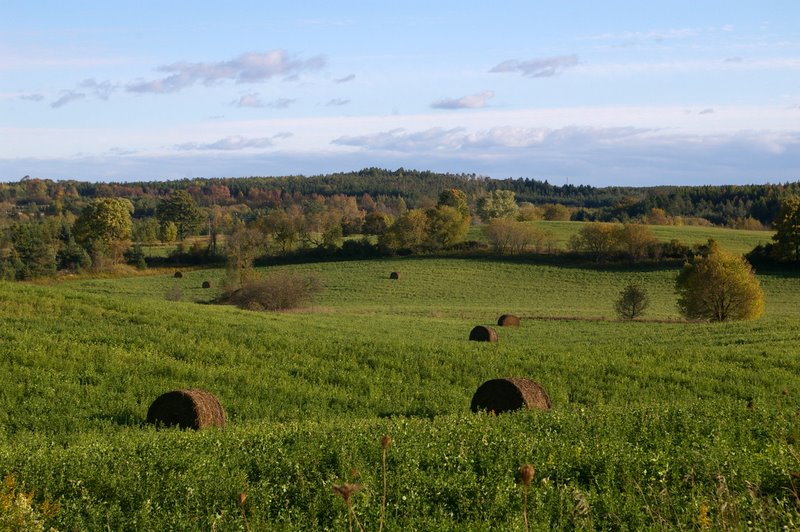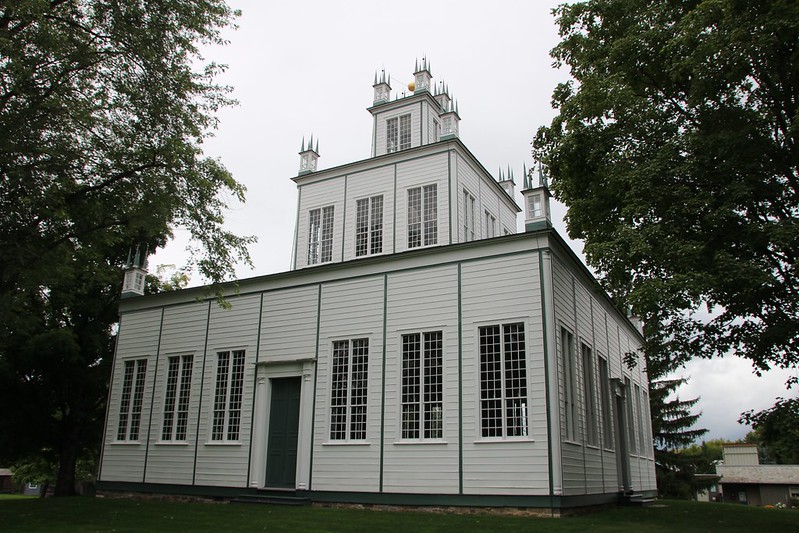East Gwillimbury, Ontario, incorporated as a town in 1971, population 34,637 (2021 census), 23,991 (2016 census). Located in York Region, East Gwillimbury’s northern border is less than a kilometre from Lake Simcoe. Historic communities within East Gwillimbury include Sharon, Holland Landing, Queensville and Mount Albert. As of 2021, the town was Canada’s fastest growing municipality of over 5,000 people, with a population increase of over 44 per cent between 2016 and 2021.
Throughout history, the East Gwillimbury area has been home to different Indigenous groups, namely the Wendat (Huron), Tionontati (Petun), Haudenosaunee and Anishinaabeg, including the Chippewas of Georgina Island First Nation. The land is part of the Williams Treaties (1923).

Indigenous Peoples
Indigenous peoples have lived in the East Gwillimbury area for thousands of years. From the mid-15th century to the mid-17th century, the area was home to the Wendat (Huron) and Tionontati (Petun). During the Iroquois Wars of the mid-1600s, the Haudenosaunee, who at the time lived in what is now northern New York State, dispersed the Wendat and Tionontati. In the late 1600s, the Anishinaabeg moved from land north of Lakes Huron and Superior into Southern Ontario, pushing most of the Haudenosaunee back to New York State. Ancestors of the Chippewas of Georgina Island, an Anishinaabe nation, began living in the Lake Simcoe region. Today, two of this First Nation’s three reserves are located northeast of East Gwillimbury, on the shore of Lake Simcoe and on Georgina Island (see also Reserves in Ontario). As of the 2021 census, Indigenous peoples make up 1.4 per cent of East Gwillimbury’s population.
Treaties
Initially, the Upper Canada government acquired the land within East Gwillimbury via the Johnson-Butler Purchase. While the first negotiations for this treaty took place in 1787 between the government and the Mississaugas, later discussions in 1795 and 1798 included the Chippewas of the East Gwillimbury area.
The terms of the Johnson-Butler Purchase were poorly documented and unclear. Because of this the government brokered two new treaties, known as the Williams Treaties, with the Chippewa and the Mississaugas in 1923. The Chippewas of Georgina Island signed the first of the two treaties, along with Chippewas of Rama and Christian Island.
Did you know?
There is debate about where the names for the historic townships of North, West, and East Gwillimbury came from. Most sources say Lieutenant-Governor John Graves Simcoe named them for his wife, born Elizabeth Gwillim. Others contest they were named for her father, Thomas Gwillim. Thomas Gwillim served under James Wolfe at the Plains of Abraham.
Settlement and Development
Land within East Gwillimbury was surveyed in 1800 and divided into smaller lots. By 1809, the Township of East Gwillimbury was booming with 425 residents. (York, which would become Toronto, had 577.) Many of its earliest settlers were those who remained loyal to Britain after the American Revolution (see Loyalists in Canada).
In 1812, the Quaker community in neighbouring Newmarket expelled preacher David Willson for his religious interpretations and desire to use music in church services. Some of his congregation followed him north to East Gwillimbury, where they started the Children of Peace or Davidites. They built a prosperous farming community called Sharon, and created Upper Canada’s first farmers’ co-operative (1824) and first homeless shelter.
Did you know?
Holland Landing (a community now within East Gwillimbury) had a blacksmith named Samuel Lount. From 1834 to 1836, Lount served in Upper Canada’s Legislative Assembly. Seeking responsible government, he commanded troops in the Upper Canada Rebellion of 1837. After the rebellion, Lount was executed for treason.
In addition to Sharon, other communities grew throughout the Township of East Gwillimbury. Holland Landing developed around a mill on Yonge Street, built about 1821. It initially thrived as a shipping port, but lost significance after the completion of a railway in 1853.
Northeast of Holland Landing, the community of Queensville established a school by 1826, and in 1851, a post office. Mount Albert, today on the eastern edge of East Gwillimbury, earned a post office in 1852, named Newland. Queen Victoria’s son Albert Edward (later Edward VII) visited the area in 1860, and the community was renamed for him in 1864.
Both the Town of East Gwillimbury and York Region were created on 1 January 1971. East Gwillimbury’s southern border shifted, as Newmarket took land from Davis Drive to roughly Green Lane.
East Gwillimbury continues to be composed largely of agricultural land. In 2005, the provincial government protected portions of the town, mostly in the north, through the Greenbelt Act. The Act protects agricultural land and natural heritage around Toronto.
While provincial legislation looks to create density over suburban sprawl, East Gwillimbury remains largely car dependent. The province plans to build a Bradford Bypass highway connecting Highway 404 in East Gwillimbury to Highway 400 in Bradford-West Gwillimbury. First studied in 1997, the route would travel through the Holland Marsh.
Population
While East Gwillimbury has already grown significantly — from 23,991 at the 2016 census to 34,637 at the 2021 census — future growth is expected to further accelerate. Town planners estimate a population of 86,500 by 2031.
East Gwillimbury’s population is ethnically diverse. According to the 2021 census, prominent ethnic groups within the town include English (20.1 per cent), Scottish (15.7 per cent), Irish (14.4 per cent), Canadian (13.7 per cent), Chinese (10.7 per cent), Italian (9.6 per cent) and German (7.3 per cent). Common countries of origin for immigrants living in East Gwillimbury include China, Iran and the United Kingdom.
Economy and Labour Force
Notable companies based in East Gwillimbury include Technicore, whose tunnel boring projects include the Eglinton Crosstown LRT line in Toronto. Loblaw Companies Limited anticipates employing 1,000 people at its new warehouse in town, expected to open in 2025. As of 2020, the agricultural sector employed roughly 15 per cent of the population.
Government and Politics
East Gwillimbury is divided into three wards, each of which elects two town councillors. The town’s mayor also serves on York Region council, casting one of its 22 votes.
Services are split between the upper- and lower-tier municipalities. The town provides services such as water and wastewater, most roads, libraries, recreation and fire services. York Region provides services such as public health, public housing, transit and paramedics.

Cultural Life
East Gwillimbury has over 37 km of trails, notably the Radial Line Trail along the historic route of a streetcar-like rail system, and the Nokiidaa Trail, which connects East Gwillimbury to Georgina to the north and Aurora to the south.
Sharon Temple National Historic Site and Museum tells the story of the Children of Peace. The site was abandoned in the 1880s, and some buildings demolished. Toronto’s York Pioneer and Historical Society saved the remaining buildings, opening a museum in 1918.
Agnes Macphail first became politically active while in Sharon. After moving to Grey County, she was the first female elected as a member of parliament, in 1921. A road in Queensville is named for comedic actor John Candy, who owned a farm in the community.

 Share on Facebook
Share on Facebook Share on X
Share on X Share by Email
Share by Email Share on Google Classroom
Share on Google Classroom



